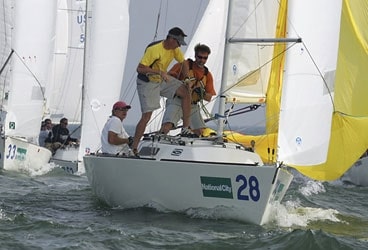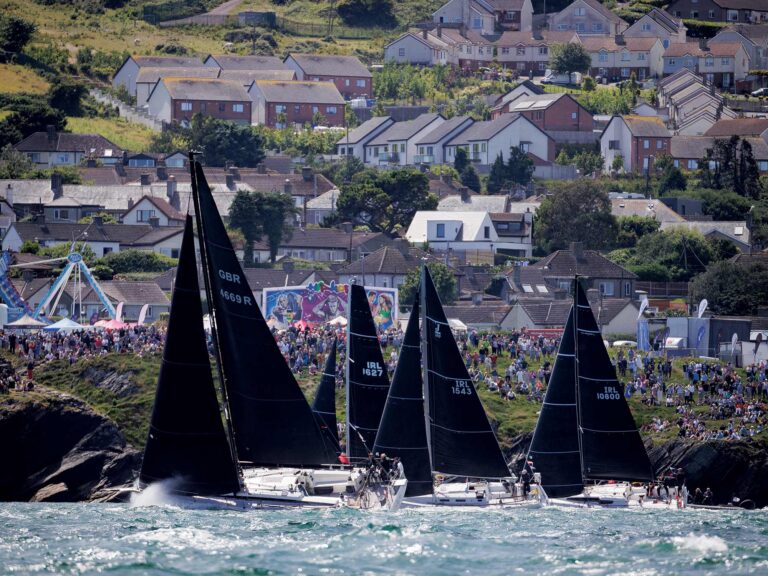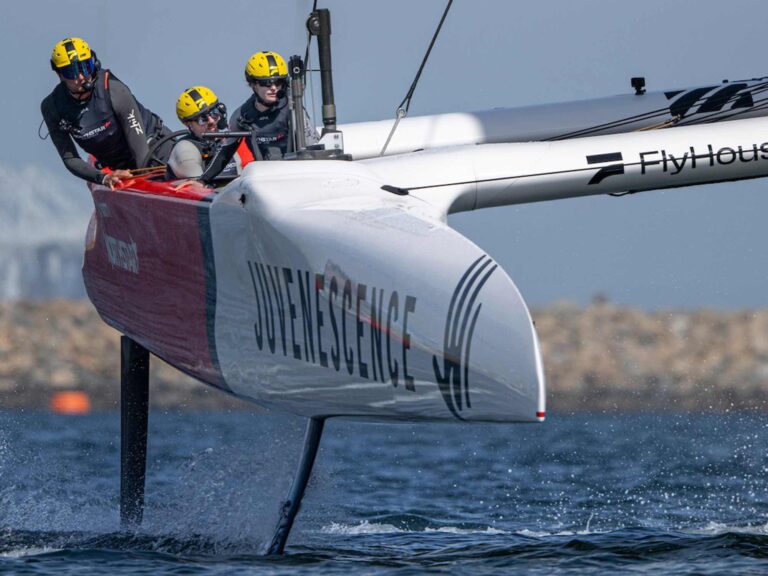
FBEiberHiller368
Greg Fisher can do no wrong in 2007. By our count, the North Sails One-Design sailmaker has won Thistle Midwinters East, J/22 Midwinters, Sperry Top-Sider Annapolis NOOD, and this past weekend, the National City J/22 North American Championship in Cleveland.In fact, Fisher has provided so many opportunities for us to ask him how he wins, and has been so generous with the knowledge he shares, we’ve decided to pass the mic to a party just as deserving– his crew. Jeff Eiber has been Fisher’s right-hand man since 1981, playing an integral role in several national championship efforts. Todd Hiller, on the other hand, is more often found sailing against Fisher in the Annapolis J/22 fleet. He joined Fisher and Eiber for the Annapolis NOOD victory in April, and again for last week’s North Americans win. When, off the starting line, Fisher sails from five boatlengths below your lee bow to five boatlenghts above in a matter of seconds, he makes driving a sailboat look like some supernatural power. But read how his crew adds to the equation, and Fisher’s winning ways may not seem so mysterious after all.
Besides your boathandling tasks, what does Greg ask from you as crew?
Eiber: As much info as possible about two different things: First, what is going on with the competition on the racecourse? Where are other boats headed? What does that mean about what the wind is doing. Are boats lifted on one side of the course? Is there more wind on either side? The other thing is, how is our boatspeed relative to the boats around us? This lets Greg adjust his setup to make the boat go fast. Hiller: We’ve both got our heads spinning trying to give as much pertinent information that will keep the boat moving fast as it can. Calling waves, puffs, etc. If there’s someone off our hip, it doesn’t take both Jeff and I to say we’re going faster or slower. Usually, Jeff will spin around and talk about the boat to windward, and I’ll be looking out for breeze and trying to paint a picture of what’s ahead.
Jeff, you’ve been sailing with Greg since 1981. How has his sailing style changed in that time?
Eiber: He’s calmed down a bit, but not much, and he’s a little less frustrated with being unable to control events on the racecourse that are out of his control. It used to be if one side came in big it was a big disaster, you know? But there’s nothing you can do about things like that. Now he just tries to put himself in a position to maximize the gains and minimize the losses. He’s a little more patient, and he knows that you can only be in one place at a time.
Todd, you normally sail against Greg in Annapolis. Did crewing for him this week help you identify his Achilles heel?
Hiller: Well if I have found his Achilles heel I’m certainly not telling anybody! I think he and Jeff are two great guys who I’ve got a lot of respect for, sailing with or against, and sailing with them has been sort of a dream come true. I mean, Greg and I sailed the Annapolis NOOD and we won that, and we decided to give it another try for the NAs. And you know i think the three of us have developed a certain chemistry that’s worked quite well. That in and of itself is important: If things get heated on the racecourse it’s nothing personal, and the moment we cross the finish line we talk about the race a bit and then say, “Okay, let’s go get the next race.”
We had the unfortunate experience of starting near you guys a few races and I got to witness firsthand how you squirted out on the pack and maintained your lane up the first part of the beat. Can you walk me through a typical starting process from, say, one minute out?
Hiller: I can tell you exactly what we did. Jeff and I told Greg to go. Greg has the tendency to point like a tour guide at Disney, and we had to tell him, “Okay, what you want to do is parallel these other boats and go fast forward, then do your pointing thing.”
Eiber: One thing that’s really valuable that we figured out was, in those conditions [less wind than waves], you had to be trimmed in and going at 15 seconds. We’d put our bow down a little so not to be over the line. We didn’t want our nose out in front of other boats, but we wanted to be moving with tremendous speed, so we’d be bow down at 8 seconds and then head up after 5 seconds so that we were already trimmed and going at the start. It worked unbelievably well. To have just a little more speed than the guy to weather, then you come up underneath them and they’re done. The leeward boat has such an advantage in that situation. Hiller: The leeward boat has total control there. Eiber: The other thing that was a big advantage for us was being able to sail just a little bit higher than the boat to leeward. That would open up a lane so we didn’t have a leeward boat right underneath us. And I guess we were fortunate that we didn’t have somebody to leeward doing the same thing to us that we were doing to the weather boat. Hiller: We didn’t always start with a clear lane, but being able to go to weather a bit more than the other guy let us sail off the leeward boat. Speed and height will get you out of a lot of trouble, there’s no question about that.
On Sunday, the wind started out strong then died all day. How did you change gears?
Eiber: I don’t really know, Greg was doing all that. Hiller: The second day of the regatta we were on the rig like gospel, making sure we were totally in tune, moving the jib leads to get the best bang for the buck in whatever conditions we were experiencing. I made the comment to Greg, “It doesn’t matter if the keel’s on backwards, if the rig’s tuned properly, we’ll go fast.” The big thing with these boats is the rig has to be in tune with the boat and the conditions. You have to set the mast up to match your sail.Plus, Greg’s really good about walking around and making sure everybody’s going fast. He’s always looking out for his customers, you might say. If somebody has a problem with their speed, they’re not afraid to ask. Even on the day we didn’t sail, Greg was walking around lengthening headstays, tuning rigs. And then next day people were thumbs up.Eiber: Greg really likes to help people out, he likes to make everybody go faster. You know, there’s not a whole lot you can do to help somebody go the right way, but you can get them set up to go fast.
For results from the 2007 National City J/22 North American Championship, click here. To read Michael Lovett’s daily blog entries from the event, click here
.









